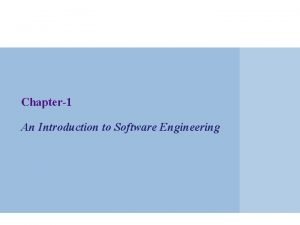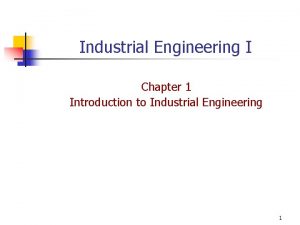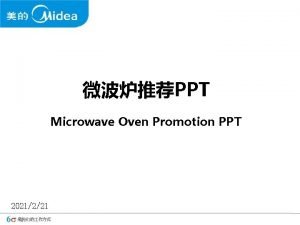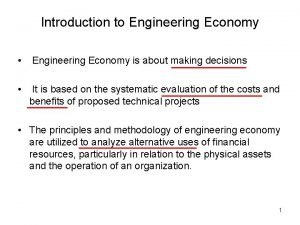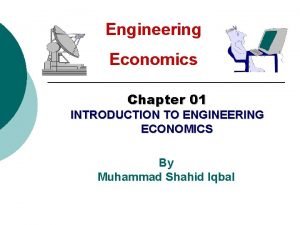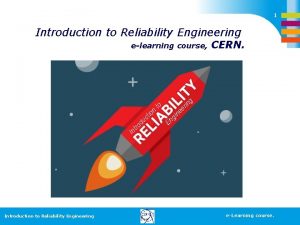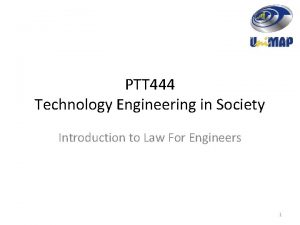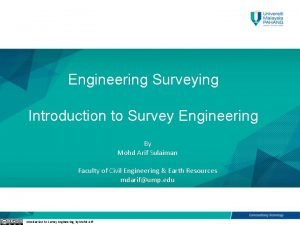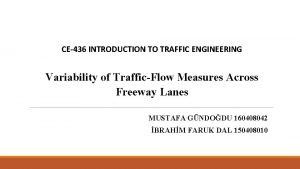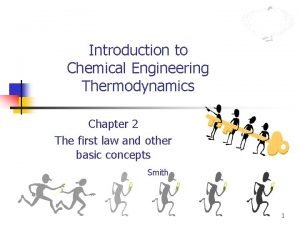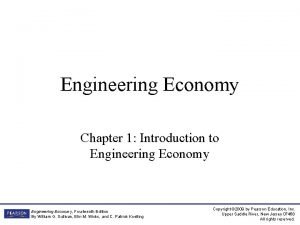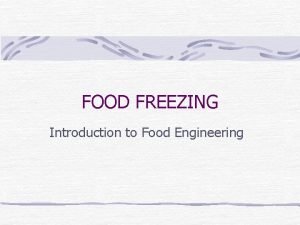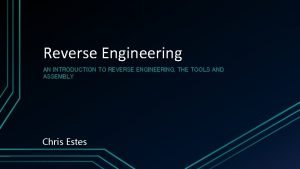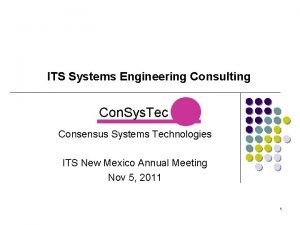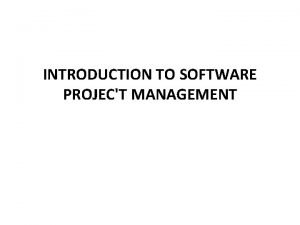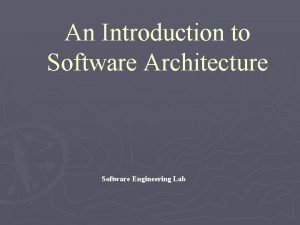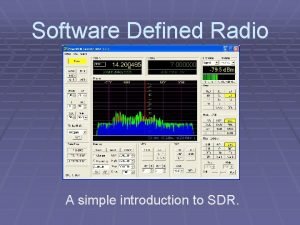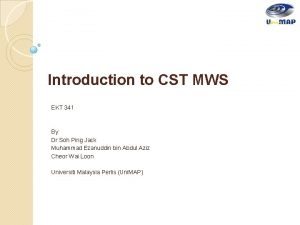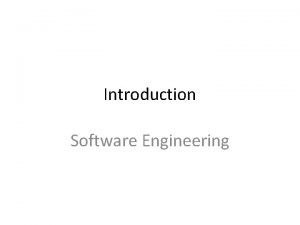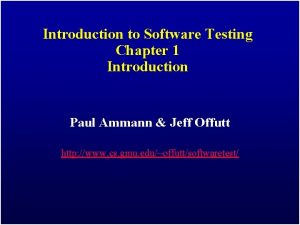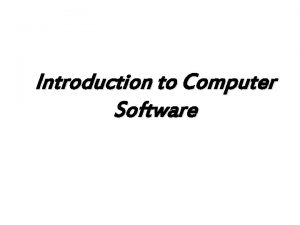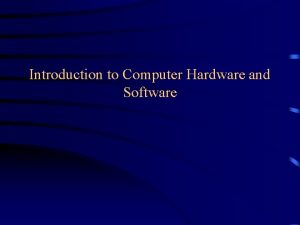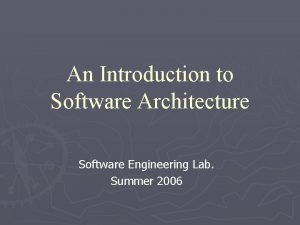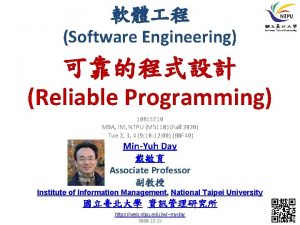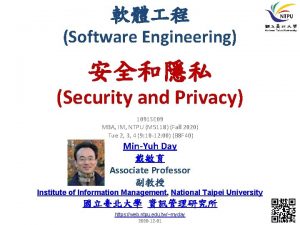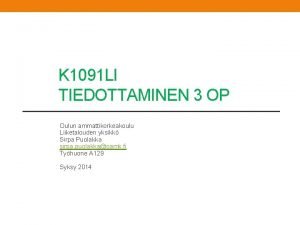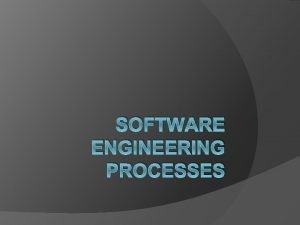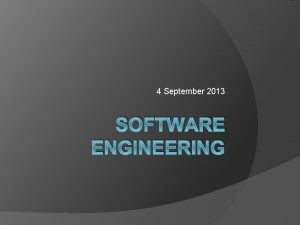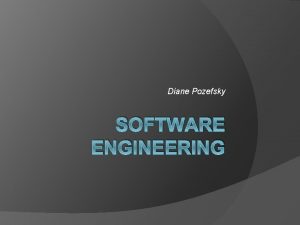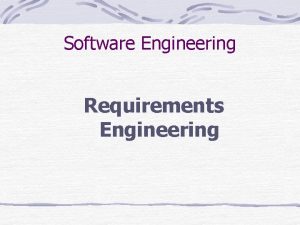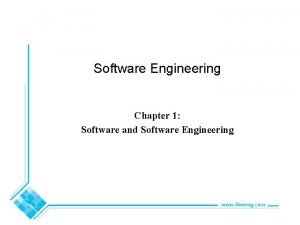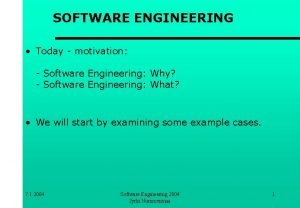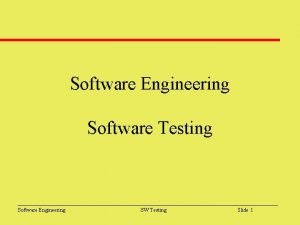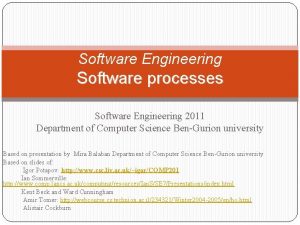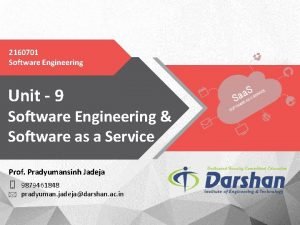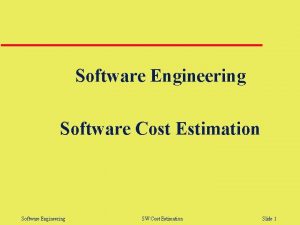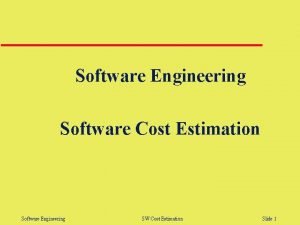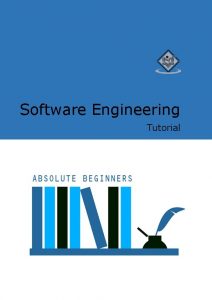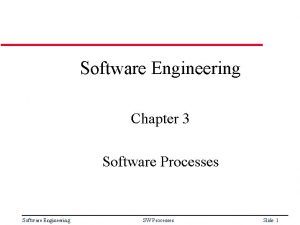Software Engineering Introduction to Software Engineering 1091 SE









































- Slides: 41

軟體 程 (Software Engineering) 軟體 程概論 (Introduction to Software Engineering) 1091 SE 01 MBA, IM, NTPU (M 5118) (Fall 2020) Tue 2, 3, 4 (9: 10 -12: 00) (B 8 F 40) Min-Yuh Day 戴敏育 Associate Professor 副教授 Institute of Information Management, National Taipei University 國立臺北大學 資訊管理研究所 https: //web. ntpu. edu. tw/~myday 2020 -09 -15 1

戴敏育 博士 (Min-Yuh Day, Ph. D. ) 國立台北大學 資訊管理研究所 副教授 中央研究院 資訊科學研究所 訪問學人 國立台灣大學 資訊管理 博士 Publications Co-Chairs, IEEE/ACM International Conference on Advances in Social Networks Analysis and Mining (ASONAM 2013 - ) Program Co-Chair, IEEE International Workshop on Empirical Methods for Recognizing Inference in TExt (IEEE EM-RITE 2012 - ) Publications Chair, The IEEE International Conference on Information Reuse and Integration (IEEE IRI) 2

軟體 程 (Software Engineering) Contact Information 戴敏育 博士 (Min-Yuh Day, Ph. D. ) 副教授 (Associate Professor) 國立臺北大學 資訊管理研究所 Institute of Information Management, National Taipei University 電話: 02 -86741111 ext. 66873 研究室: 商8 F 12 地址: 23741 新北市三峽區大學路 151 號 Email:myday@gm. ntpu. edu. tw 網址:http: //web. ntpu. edu. tw/~myday/ 3



Course Objectives 1. Understand the fundamental concepts and research issues of software engineering. 2. Equip with Hands-on practices of software engineering. 3. Conduct information systems research in the context of software engineering. 6


Course Outline • This course introduces the fundamental concepts, research issues, and hands-on practices of software engineering. • Topics include 1. 2. 3. 4. 5. 6. 7. 8. 9. 10. 11. 12. 13. Introduction to Software Engineering Software Products and Project Management: Software product management and prototyping Agile Software Engineering: Agile methods, Scrum, and Extreme Programming Features, Scenarios, and Stories Software Architecture: Architectural design, System decomposition, and Distribution architecture Cloud-Based Software: Virtualization and containers, Everything as a service, Software as a service Cloud Computing and Cloud Software Architecture Microservices Architecture, RESTful services, Service deployment Security and Privacy Reliable Programming Testing: Functional testing, Test automation, Test-driven development, and Code reviews Dev. Ops and Code Management: Code management and Dev. Ops automation Case Study on Software Engineering 8


校四大基本素養 (Four Fundamental Qualities) • 專業 (Professionalism) – 創意思考與問題解決 (Creative thinking and Problem-solving) 30 % – 綜合統整(Comprehensive Integration) 30 % • 人際 (Interpersonal Relationship) – 溝通協調 (Communication and Coordination) 10 % – 團隊合作 (Teamwork) 10 % • 倫理 (Ethics) – 誠信正直(Honesty and Integrity) 5 % – 尊重自省(Self-Esteem and Self-reflection) 5 % • 國際觀 (International Vision) – 多元關懷 (Caring for Diversity) 5 % – 跨界宏觀 (Interdisciplinary Vision) 5 % 10

商學院學習目標 (College Learning Goals) • • Ethics/Corporate Social Responsibility Global Knowledge/Awareness Communication Analytical and Critical Thinking 11

系所學習目標 (Department Learning Goals) • Information Technologies and System Development Capabilities • Research capabilities 12

課程大綱 (Syllabus) 週次 (Week) 日期 (Date) 內容 (Subject/Topics) 1 2020/09/15 軟體 程概論 (Introduction to Software Engineering) 2 2020/09/22 軟體產品與專案管理:軟體產品管理,原型設計 (Software Products and Project Management: Software product management and prototyping) 3 2020/09/29 敏捷軟體 程:敏捷方法、Scrum、極限程式設計 (Agile Software Engineering: Agile methods, Scrum, and Extreme Programming) 4 2020/10/06 功能、場景和故事 (Features, Scenarios, and Stories) 5 2020/10/13 軟體架構:架構設計、系統分解、分散式架構 (Software Architecture: Architectural design, System decomposition, and Distribution architecture) 6 2020/10/20 軟體 程個案研究 I (Case Study on Software Engineering I) 13

課程大綱 (Syllabus) 週次 (Week) 日期 (Date) 內容 (Subject/Topics) 7 2020/10/27 基於雲的軟體:虛擬化和容器、軟體即服務 (Cloud-Based Software: Virtualization and containers, Everything as a service, Software as a service) 8 2020/11/03 雲端運算與雲軟體架構 (Cloud Computing and Cloud Software Architecture) 9 2020/11/10 期中報告 (Midterm Project Report) 10 2020/11/17 微服務架構:RESTful服務、服務部署 (Microservices Architecture, RESTful services, Service deployment) 11 2020/11/24 軟體 程產業實務 (Industry Practices of Software Engineering) 12 2020/12/01 安全和隱私 (Security and Privacy) 14

課程大綱 (Syllabus) 週次 (Week) 日期 (Date) 內容 (Subject/Topics) 13 2020/12/08 軟體 程個案研究 II (Case Study on Software Engineering II) 14 2020/12/15 可靠的程式設計 (Reliable Programming) 15 2020/12/22 測試:功能測試、測試自動化、 測試驅動的開發、程式碼審查 (Testing: Functional testing, Test automation, Test-driven development, and Code reviews) 16 2020/12/29 Dev. Ops和程式碼管理: 程式碼管理和Dev. Ops自動化 (Dev. Ops and Code Management: Code management and Dev. Ops automation) 17 2021/01/05 期末報告 I (Final Project Report I) 18 2021/01/12 期末報告 II (Final Project Report I) 15

教學方法與教學活動 (Teaching methods and activities) • 講授 (Lecture) • 討論 (Discussion) • 實習 (Practicum) 16

評量方式 (Evaluation Methods) • • • 個人報告 (Individual Presentation) 60 % 團體報告 (Group Presentation) 10 % 個案分析報告 (Case Report) 10 % 課堂參與 (Class Participation) 10 % 作業 (Assignment) 10 % 17

指定用書 (Required Texts) • Ian Sommerville (2019), Engineering Software Products: An Introduction to Modern Software Engineering, Pearson. 18

參考書目 (Reference Books) • Ian Sommerville (2015), Software Engineering, 10 th Edition, Pearson. • Titus Winters, Tom Manshreck, and Hyrum Wright (2020), Software Engineering at Google: Lessons Learned from Programming Over Time, O'Reilly Media. 19

Ian Sommerville (2019), Engineering Software Products: An Introduction to Modern Software Engineering, Pearson. Source: https: //www. amazon. com/Engineering-Software-Products-Ian-Sommerville/dp/013521064 X 20

Ian Sommerville (2015), Software Engineering, 10 th Edition, Pearson. Source: https: //www. amazon. com/Software-Engineering-10 th-Ian-Sommerville/dp/0133943038 21

Titus Winters, Tom Manshreck, and Hyrum Wright (2020), Software Engineering at Google: Lessons Learned from Programming Over Time, O'Reilly Media. Source: https: //www. amazon. com/Software-Engineering-Google-Lessons-Programming/dp/1492082791 22

Software Engineering 23

Information Management Information Systems (MIS) Information Systems 24

Information Management (MIS) Information Systems Source: Kenneth C. Laudon & Jane P. Laudon (2014), Management Information Systems: Managing the Digital Firm, Thirteenth Edition, Pearson. 25

Fundamental MIS Concepts Business Challenges Management Organization Information System Business Solutions Technology Source: Kenneth C. Laudon & Jane P. Laudon (2014), Management Information Systems: Managing the Digital Firm, Thirteenth Edition, Pearson. 26

Project-based software engineering CUSTOMER Problem generates 1 helps-with implemented-by Requirements Software CUSTOMER and DEVELOPER Source: Ian Sommerville (2019), Engineering Software Products: An Introduction to Modern Software Engineering, Pearson. 27

Project-based software engineering • The starting point for the software development is a set of ‘software requirements’ that are owned by an external client and which set out what they want a software system to do to support their business processes. • The software is developed by a software company (the contractor) who design and implement a system that delivers functionality to meet the requirements. • The customer may change the requirements at any time in response to business changes (they usually do). The contractor must change the software to reflect these requirements changes. • Custom software usually has a long-lifetime (10 years or more) and it must be supported over that lifetime. Source: Ian Sommerville (2019), Engineering Software Products: An Introduction to Modern Software Engineering, Pearson. 28

Product software engineering DEVELOPER 1 Opportunity inspires Product features DEVELOPER realizes implemented-by Software DEVELOPER Source: Ian Sommerville (2019), Engineering Software Products: An Introduction to Modern Software Engineering, Pearson. 29

Product software engineering • The starting point for product development is a business opportunity that is identified by individuals or a company. They develop a software product to take advantage of this opportunity and sell this to customers. • The company who identified the opportunity design and implement a set of software features that realize the opportunity and that will be useful to customers. • The software development company are responsible for deciding on the development timescale, what features to include and when the product should change. • Rapid delivery of software products is essential to capture the market for that type of product. Source: Ian Sommerville (2019), Engineering Software Products: An Introduction to Modern Software Engineering, Pearson. 30

Software execution models Stand-alone execution Hybrid execution Software as a service User’s computer User interface Product functionality User data User interface Partial functionality User data User interface (browser or app) Product updates Additional functionality User data backups Product updates Product functionality User data Vendor’s servers Source: Ian Sommerville (2019), Engineering Software Products: An Introduction to Modern Software Engineering, Pearson.

Product management concerns Business needs Product manager Technology constraints Customer experience Source: Ian Sommerville (2019), Engineering Software Products: An Introduction to Modern Software Engineering, Pearson. 32

Technical interactions of product managers Product vision management Product backlog management Product manager Acceptance testing User stories and scenarios Customer testing User interface design Source: Ian Sommerville (2019), Engineering Software Products: An Introduction to Modern Software Engineering, Pearson. 33

Marketing 34

Marketing “Meeting needs profitably” Source: Philip Kotler and Kevin Lane Keller (2016), Marketing Management, 15 th edition, Pearson. 35

Marketing “Marketing is an organizational function and a set of processes for creating, communicating, and delivering value to customers and for managing customer relationships in ways that benefit the organization and its stakeholders. ” Source: Philip Kotler and Kevin Lane Keller (2016), Marketing Management, 15 th edition, Pearson. 36

Marketing Management 37

Marketing Management “Marketing management is the art and science of choosing target markets and getting, keeping, and growing customers through creating, delivering, and communicating superior customer value. ” Source: Philip Kotler and Kevin Lane Keller (2016), Marketing Management, 15 th edition, Pearson. 38

1 2 3 4 5 6 7 8 Marketing Management Understanding Marketing Management Capturing Marketing Insights Connecting with Customers Building Strong Brands Creating Value Delivering Value Communicating Value Conducting Marketing Responsibly for Long-term Success Source: Philip Kotler and Kevin Lane Keller (2016), Marketing Management, 15 th edition, Pearson. 39

Summary • This course introduces the fundamental concepts, research issues, and hands-on practices of software engineering. • Topics include 1. 2. 3. 4. 5. 6. 7. 8. 9. 10. 11. 12. 13. Introduction to Software Engineering Software Products and Project Management: Software product management and prototyping Agile Software Engineering: Agile methods, Scrum, and Extreme Programming Features, Scenarios, and Stories Software Architecture: Architectural design, System decomposition, and Distribution architecture Cloud-Based Software: Virtualization and containers, Everything as a service, Software as a service Cloud Computing and Cloud Software Architecture Microservices Architecture, RESTful services, Service deployment Security and Privacy Reliable Programming Testing: Functional testing, Test automation, Test-driven development, and Code reviews Dev. Ops and Code Management: Code management and Dev. Ops automation Case Study on Software Engineering 40

軟體 程 (Software Engineering) Contact Information 戴敏育 博士 (Min-Yuh Day, Ph. D. ) 副教授 (Associate Professor) 國立臺北大學 資訊管理研究所 Institute of Information Management, National Taipei University 電話: 02 -86741111 ext. 66873 研究室: 商8 F 12 地址: 23741 新北市三峽區大學路 151 號 Email:myday@gm. ntpu. edu. tw 網址:http: //web. ntpu. edu. tw/~myday/ 41
 Types of software changes
Types of software changes Introduction to software engineering course outline
Introduction to software engineering course outline What is system design in software engineering
What is system design in software engineering Forward engineering and reverse engineering
Forward engineering and reverse engineering Software maintenance process models ppt
Software maintenance process models ppt Frank maurer
Frank maurer Metrics computer science
Metrics computer science Software crisis in software engineering
Software crisis in software engineering Software metrics and software metrology
Software metrics and software metrology Real time software design in software engineering
Real time software design in software engineering Design principles in software engineering
Design principles in software engineering Body paragraph
Body paragraph Isometric projections
Isometric projections Introduction to civil engineering
Introduction to civil engineering Industrial engineering tools
Industrial engineering tools Microwave devices ppt
Microwave devices ppt Web engineering lectures ppt
Web engineering lectures ppt Introduction to engineering economy
Introduction to engineering economy Introduction to engineering economics
Introduction to engineering economics Introduction to reliability engineering
Introduction to reliability engineering Ptt 444
Ptt 444 Introduction to engineering surveying
Introduction to engineering surveying Introduction to traffic engineering
Introduction to traffic engineering Introduction to technical drafting
Introduction to technical drafting Thermodynamics chapter 2
Thermodynamics chapter 2 Engineering economy problems
Engineering economy problems Introduction to food engineering
Introduction to food engineering Introduction to reverse engineering
Introduction to reverse engineering Introduction to systems engineering consulting
Introduction to systems engineering consulting Principles of complex systems for systems engineering
Principles of complex systems for systems engineering Engineering elegant systems: theory of systems engineering
Engineering elegant systems: theory of systems engineering Reverse engineering vs forward engineering
Reverse engineering vs forward engineering Introduction to software project management
Introduction to software project management Computerised accounting system notes
Computerised accounting system notes An introduction to software architecture
An introduction to software architecture Softrock sdr
Softrock sdr Cst software introduction
Cst software introduction Introduction to computer software
Introduction to computer software 5ttt6
5ttt6 Hardware introduction
Hardware introduction Introduction of computer hardware
Introduction of computer hardware Introduction to software architecture
Introduction to software architecture
